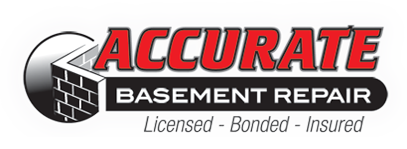A recent report by CBS News tells of a town with widespread cracking of foundations and walls in it. One resident noticed mushrooms in her bedroom and realized that her bedroom windows were leaking. It was due to the whole side of the house sinking because it had foundation cracks in it. Homeowners in southeastern Wisconsin and across the nation also must deal with the possibility of foundation disintegration. In Milwaukee, the heavy clay makes poured concrete needed to withstand the annual movements of the soil due to temperature changes. We at Accurate Basement Repair have long experience in assessing and repairing basements in our area.
We offer Wisconsin basement waterproofing services that can prevent damage or further damage to your basement floor. If it has flooded in the past, shows water damage or streak marks, has seepage at the floor-wall joint (cove), odd odors, unpleasant mold, peeling paint, or a white chalky residue on the walls called efflorescence, then it is a good idea to have the basement waterproofed. We install sump pumps, fix up draining systems, place dehumidifiers, and more to water proof your basement.
Most concrete soon develops cracks due to the shrinkage and movements of the concrete. If they are merely hairline cracks, it may be no problem. However, check to see if the crack is wider at one end than at the other. If it is, there may be foundation settling that is hurting the concrete floor or walls. You can call us for an inspection or repair. We can fill in leaking or dangerous foundation cracks with urethane grout by drilling small holes into the wall through which to insert the grout. The holes are too small to weaken the wall and are later re-filled with concrete. Urethane is moisture-cured and sticks to the concrete even if the concrete is wet at the time. It becomes foamy, fills in the foundation cracks, then hardens and resists water, bugs, and chemicals.
Erosion or expansion and contraction of clay can cause settling or tipping of homes with concrete foundations. We use two main types of piering (underpinning) to correct the problem. Helical piers extend the foundation deeper or wider to put it on a more solid soil layer or to spread out the load. Steel push piers are sunk down into the ground until resting on stronger soils below. Thus the walls that bear the weight of the house are made stronger and more stable. We can assess which method may be best for your foundation and get the job done right the first time.





